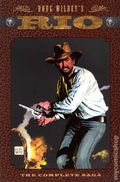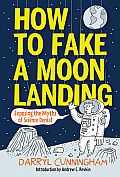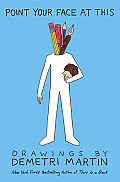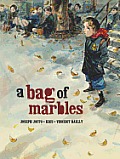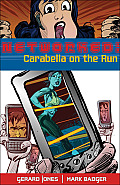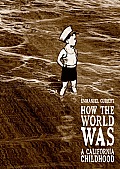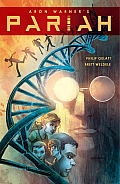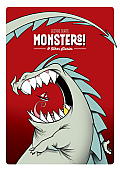Link to this review in the form of a comic strip by geneambaum tagged graphic novel • western
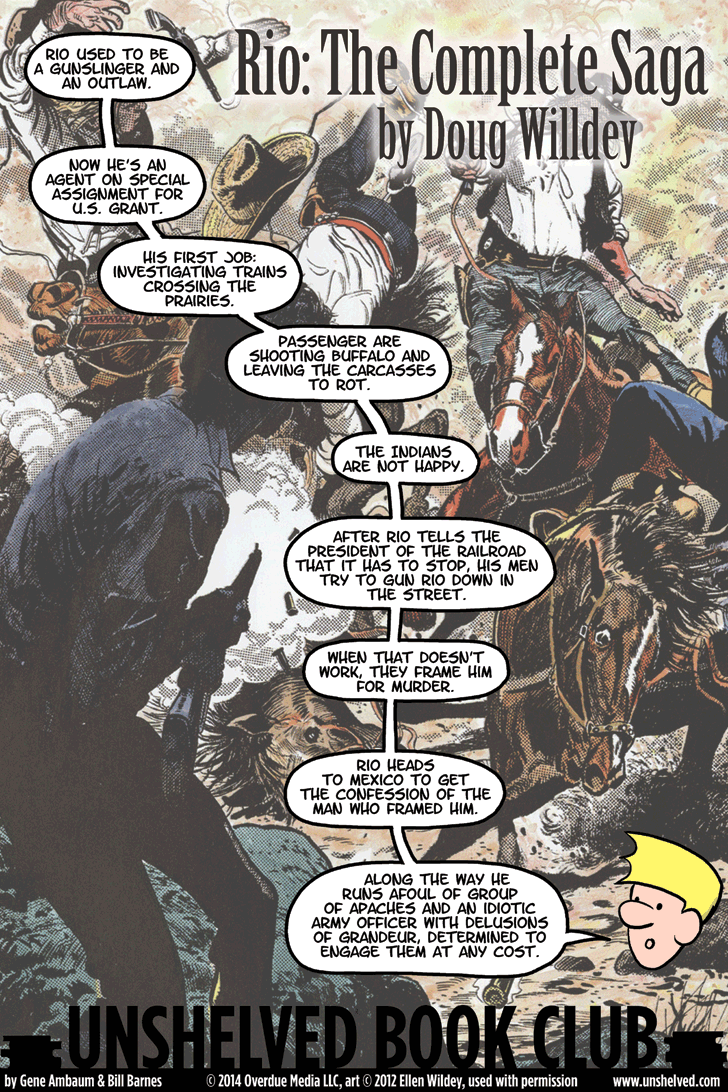
Click for the full-sized comic
@bookblurb A former outlaw works in the old west on special assignment for U.S. Grant.
Link to this review by snow tagged science • graphic novel
NASA faked the moon landing. The measles-mumps-rubella vaccine causes autism. Climate change isn’t real. These myths and more come about because people don’t understand basic science, the media downplays accurate scientific reporting, and big business doesn’t want their bottom line affected. Science writer and cartoonist Cunningham looks at seven common scientific fallacies that come from misunderstanding or denying the evidence and corrects the record.
Why I picked it up: I liked Cunningham’s previous graphic nonfiction, Psychiatric Tales: eleven graphic stories about mental illness.
Why I finished it: Both Cunningham and reporter Andrew Revkin (who writes the introduction) encourage readers to think for themselves. This is not a book that asks for blind devotion. Revkin says that he doesn’t necessarily agree with all of Cunningham’s findings (and neither do I). There are things I want to research for myself after reading this, especially the dangers of basic chiropractic manipulation. This is what Cunningham wants. In his preface, he says, “This book is pro-science and pro-critical thinking. It isn’t a book promoting a scientific elite whom we all must follow, sheep-like.” Revkin backs him up, saying, “Dig in. Find out how to use Google Scholar to probe basic research. Read a scientific paper. Talk to a scientist! They’re not hard to find, and most are eager to help the public understand their work.” After reading this, I wanted to do just that, and, even though I do not have any kind of scientific background, I felt that I could by simply reading, exploring, and thinking over the evidence.
It’s perfect for: My step-grandfather, Mac. As a retired engineer, he’ll be intrigued by Cunningham’s research. Mac is always a proponent of asking questions. Plus he’s never read a graphic novel before. Luckily Cunningham’s art is very simple. He favors six panels per page, each square with a block of text at the top and a simple illustration. The format will be a good one for Mac — he won’t spend much effort figuring it out.
@bookblurb A cartoonist examines seven common scientific fallacies and corrects the record.
Link to this review by darcy tagged comic strips • humor
A collection of cartoons by comedian Demetri Martin that covers life, the arts, social science, and puns.
Why I picked it up: I think Demetri Martin is one of the funniest comedians out there. I love how he incorporates drawing into his stand up.
Why I finished it: Every page had me laughing out loud, from the innocent Cornicorn, a corn on the cob with a unicorn horn, to the drawing of a polygamist with multiple balls and chains around his legs. Everyone around me wondered what I was laughing at and grabbed the book to take a peek. It became social as the book was passed around to friends and coworkers. At the risk of giving away the ending, I enjoyed the last page which was simply marked “an end.”
It’s perfect for: Beau, a coworker I once had who kept The Far Side calendars at his desk. I know he’d love the Martin cartoons because they operate on different levels, often in the same way The Far Side did. One that kept me laughing was a drawing of Death with a caddy who was carrying a bunch of scythes. Another shows Tinkerbell stuck to flypaper.
@bookblurb Pun-filled cartoons by comedian Demetri Martin.
Link to this review by wally tagged historical fiction • graphic novel • coming of age
Jo and Maurice, two Jewish boys living in occupied Paris with their parents, must hide their identities and head for the south of France, where their brothers live. Danger and suspicion shadow their lives, but they live on their wits and, with the help of some good people, survive the war.
Why I picked it up: I’ve been reading a lot about wartime France lately, and this book seemed like a quick tour (at only 125 pages) into that territory.
Why I finished it: The opening scene, in which Maurice and Jo prank Nazi officers into getting a haircut at their father’s barber shop, riveted me for eight tense pages. I had to know more about these two rascals and their family, and whether they would make it through the war.
The writer-artist team shortened Joffo’s memoir considerably, and the moody watercolors evoke both the war and the desire for freedom.
It’s perfect for: Paul, whose family had their own scrape with the Nazis back in WW II, and who would appreciate how the boys’ father teaches them that they must never, ever admit they are Jewish. He even slaps Jo to make the point. When Nazis later ask him “What is a Jew?” he shrugs and says “I don’t really know.”
@bookblurb Two Jewish boys in occupied Paris live by their wits during WW II.
Link to this review by wally tagged graphic novel • science fiction
Carabella, a blue-skinned college girl who likes shoes and values her privacy, gets in over her head when she meets Nick, an engineer working on a new kind of shoe that functions as a social media platform. After Cara’s futuristic, networked, mobile, and possibly intelligent hair extensions get out of control and she cuts them off, Nick reverse-engineers them to make his shoes even better. But Cara’s got a good reason for valuing her privacy, and when she learns what Nick has done, she must use her martial arts skills, creativity, and friends to save society from Nick’s shoes.
Why I picked it up: The premise of a blue-skinned girl who really values her privacy struck me as outlandish, but this quick, neatly plotted graphic novel pulled me in with its attention on how easily we devalue our privacy as we go about our daily routines.
Why I finished it: Carabella explains her blue skin is the result of living on a commune with hippie parents and a dip in the tie-dye vat. I knew she was lying, but I wanted to know why, along with the real reason why she was blue.
It’s perfect for: Friends who don’t think twice about posting personal information on Facebook, and who then wonder why they keep seeing the same ads online. This book is put out by Privacy Activism, a non-profit organization devoted to raising awareness about consumer privacy issues, including identity theft, data mining, and online behavioral tracking.
@bookblurb Socially networked shoes and intelligent hair extensions combine to threaten the world.
Link to this review by flemtastic tagged graphic novel • biography • coming of age
Emmanuel Guibert created a previous graphic novel based on Alan Cope’s uneventful experience serving in Europe during World War II, Alan’s War. This book is the result of their continued friendship and numerous interviews about Cope’s childhood in California. The tone is conversational, the drawings realistic, and Cope’s recollections about his childhood are varied and delicate. Cope muses about his mother’s warning against masturbation and recalls how, decades later, he was still reluctant to touch his own genitals. He learns about family squabbles and mental illness that split his family up (he didn’t know about certain aunts and uncles for years). He hunts for black widows under his house, searches the foothills for rattlesnakes, and takes family trips in a convertible. Anecdotes fill the book with the golden glow of favored memories, though there were hardships, too, like when Cope’s mother dies and his father remarries a much younger woman.
Why I picked it up: I heard the story about how the much younger Guibert struck up a friendship with Cope, and how he wrote Alan’s War as a tribute to Cope before Cope’s death. A follow-up book biography about Cope’s ordinary life in 1930s and 1940s California sounded compelling, especially since the project was being done by Guibert.
Why I finished it: There were numerous scenes with real emotional impact, like Cope’s memories of the harsh thing he said to his mother as she left on her way to the hospital for the operation that ended her life. He dealt with her death by not speaking of it. He remembers that he thought about her daily for two years after she died, and struggled with how to process her absence.
The depth of details makes this a real treasure, too. After an earthquake, his grandmother’s pianoforte continued to vibrate. Even though they piled books and other things on top of it, it made noise for hours as aftershocks continued.
It’s perfect for: My neighbor Craig. His childhood was like Cope’s in one particular way. Both used whatever was at hand to make Rube Goldberg machines to entertain themselves. Cope made a makeshift platform on roller skates and rode it down steep hills without killing himself. Craig, as a child, built a dumbwaiter that went to the second floor of his barn. Where were their parents?
@bookblurb Emmanuel Guibert’s graphic novel based on his friend Alan Cope’s tales of his California childhood.
Link to this review by geneambaum tagged science fiction • graphic novel • coming of age
Young people who were cured of a fatal genetic disease in-vitro have to live with an unexpected side effect: a rapid increase in intelligence at puberty. Some Vitros try to live normal lives, others do R&D work, and one manipulates people to create mayhem for his own amusement.
After a bio weapon is released from the Vitros R&D lab, they are seen as terrorists. As the government beings rounding them up, some resist.
Collects Pariah #1 – #4
Why I picked it up: I liked the washed out brightness of the cover. (It reminded me Ben Templesmith’s art, though it doesn’t look as sketchy.)
Why I finished it: The variety of characters. Brent Marks wants to be a normal, happy high school student, but the other kids and even his parents are afraid of him. (He’s far from normal — he’s creating a spaceship in his bedroom.) Lila Ellerman, one of the researchers hiding in the wilderness, is being framed for releasing the bio weapon. Everyone disagrees about what to do. To help get control of the situation, she brings them together by distilling alcohol and turning their hideout into a party. The creepiest is Robert Maudsley, the evil genius, who uses people to get what he wants no matter what the consequences.
Readalikes: Nancy Kress’s Beggars in Spain in which genetically modified individuals who don’t require sleep become overachievers and then outcasts, and Barry Ween: Boy Genius, about the hilarious adventures of a potty-mouthed, pop-culture referencing ten-year-old genius and his friends.
@bookblurb The government begins to round up highly intelligent young people who are the result of genetic engineering.
Link to this review by geneambaum tagged horror • science fiction • graphic novel • humor
Có!
Aliens beam up a farmer and his pigs.
Birds
Two working birds head to the office. When the hooded spectre of death comes for them, they do everything they can to avoid him.
Monsters!
A hungry, giant lizard comes ashore, followed shortly by a humungous octopus and a monstrous turtle. The city’s only hope is an old man, a magical recipe, and a syringe.
Why I picked it up: I bought a copy of the third story, then titled Monstros!, in a stand-alone volume from Duarte at 2012’s New York Comic Con. It was fantastic, so I wanted to read the other stories.
Why I finished it: Duarte’s duotone art with its beautifully exact lines hooked me. Then the weirdness reeled me in — after the farmer wakes up to find he’s been turned into a pig, there are, inexplicably, chickens everywhere, including in the fridge.
It’s perfect for: Sean and Richard, who both love Godzilla. Sean is a comic book guy, so I know he’ll like the title story for its oversized creatures and the craft that goes into the wordless stories. Richard is a photographer and a highbrow film buff who will enjoy Có! as pro-vegan propaganda.
@bookblurb Three funny and horrific short stories that will remind you of monster movies and Looney Tunes cartoons.
Link to this review by sarahhunt tagged graphic novel
The (NSFW) story of the collapse of an ant colony told through the stories of the ants who don’t fit in: a homosexual couple, a child who sees visions after inhaling worm particles, his father who seems to fit in but commits terrible crimes when alone, and a cop who questions his role in the colony.
Why I picked it up: The art is really trippy. There are bright colors everywhere, even on black ants who are highlighted by the tubes and sacs within them.
Why I finished it: The book reads like an engaging fever dream. The ants are all trying to figure out what their world means as it falls apart around them.
Readalikes: Other stories about searching for meaning in chaos, like Slaughterhouse Five and Looking for Alaska.
@bookblurb The collapse of an ant colony as seen through the stories of ants who don't fit in.
